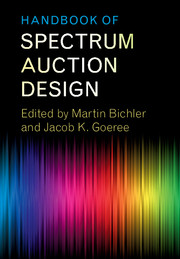Book contents
- Frontmatter
- Contents
- List of Contributors
- Preface
- List of Papers
- Part I The Simultaneous Multiple-Round Auction
- Part II The Combinatorial Clock Auction Designs
- Part III Alternative Auction Designs
- Part IV Experimental Comparisons of Auction Designs
- Part V The Bidders’ Perspective
- Part VI Secondary Markets and Exchanges
- 36 Spectrum Markets: Motivation, Challenges, and Implications
- 37 Designing the US Incentive Auction
- 38 Solving the Station Repacking Problem
- 39 ICE: An Expressive Iterative Combinatorial Exchange
- 40 ACE: A Combinatorial Market Mechanism
- Outlook
- References
40 - ACE: A Combinatorial Market Mechanism
from Part VI - Secondary Markets and Exchanges
Published online by Cambridge University Press: 26 October 2017
- Frontmatter
- Contents
- List of Contributors
- Preface
- List of Papers
- Part I The Simultaneous Multiple-Round Auction
- Part II The Combinatorial Clock Auction Designs
- Part III Alternative Auction Designs
- Part IV Experimental Comparisons of Auction Designs
- Part V The Bidders’ Perspective
- Part VI Secondary Markets and Exchanges
- 36 Spectrum Markets: Motivation, Challenges, and Implications
- 37 Designing the US Incentive Auction
- 38 Solving the Station Repacking Problem
- 39 ICE: An Expressive Iterative Combinatorial Exchange
- 40 ACE: A Combinatorial Market Mechanism
- Outlook
- References
Summary
Introduction
At the time of the Clean Air Act of 1990, the Los Angeles basin was the only region in the country classified as an extreme non-attainment area for exceeding the National Ambient Air Quality Standards for ozone. Under pressure at the national level from the Environmental Protection Agency (EPA), and at the state level from the California Air Resources Board (CARB) to significantly reduce emissions, the South Coast Air Quality Management District (SCAQMD) launched a program for trading permits in nitrogen and sulfur oxides (NOx and SOx) in the Los Angeles basin. That program was strongly supported by environmental groups and large firms in the LA basin as the most cost effective way of attaining the desired reductions. This program, the REgional CLean Air Incentives Market (RECLAIM), was initialized in October of 1993 and has been operating since early 1994.
The design of the tradable instruments was inevitably a compromise between regulatory interests and market efficiency. Regulators wanted to be able to control the timing and distribution of emissions as finely as possible with caps at many different locations and for many different time periods. To create liquidity, market designers wanted as few instruments as possible – a single aggregate cap would have been their preference. In the end, 136 different types of permits were created that could be used by a company to cover their emissions and, thereby, avoid the costs of abatement. This meant there were both substitutes and complements among the permits. Further, the markets for each of these permits would be illiquid. That created a big problem for the environmental engineers trying to choose between installing expensive abatement equipment or buying a portfolio of permits.
At the request of a number of firms, a new combinatoric market design was built and operated to help then and others deal with the complexities that the RECLAIM program created. In this chapter, we provide a description and analysis of that market.
Information
- Type
- Chapter
- Information
- Handbook of Spectrum Auction Design , pp. 874 - 902Publisher: Cambridge University PressPrint publication year: 2017
References
Accessibility standard: Unknown
Why this information is here
This section outlines the accessibility features of this content - including support for screen readers, full keyboard navigation and high-contrast display options. This may not be relevant for you.Accessibility Information
- 1
- Cited by
